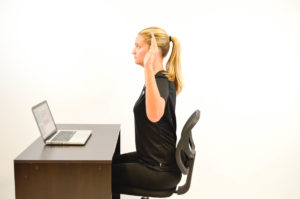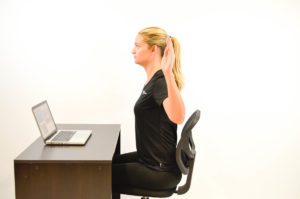
WebExercises Sports Medicine Minute: Why Sitting is the New Smoking, how it effects posture and what you can do about it.
The amount of time most people spend sitting has been constantly increasing over the last couple of decades. How can this affect our health and what can we do about it? Long periods of sitting can lead to serious health conditions such as decreased cardiovascular health, diabetes, obesity, depression or digestive issues. It also impacts our muscular system and thus our posture. Especially, sitting in front of a computer, which can lead to rounded shoulders and a forward head posture. This can ultimately increase the risk for neck and shoulder injuries such as shoulder impingement syndrome.
What can you do to decrease the risk of forward head posture?
In general, it’s a good idea to prevent sitting for more than 30 minutes at a time and take ‘movement breaks’ throughout the day. Apart from that, it’s important to integrate exercises that can help to prevent neck issues through targeted stretching or strengthening. Sneak the following 3 exercises of our ‘desk stretch library’ into the work day to prevent neck issues:
Bilateral Shoulder Flexion Stretch:

Begin sitting in chair and place both hands on desk surface.

Slowly lower shoulders toward knees as hands simultaneously slide forward on table until a gentle stretch is felt. You may push slide away from the desk as far as necessary to feel the stretch. Hold for 30 seconds. Repeat for prescribed repetitions.
Seated Scapular Retraction:

Begin seated at your desk. Shoulders should be back and head up. Raise and bend your arms so that elbows are near shoulder level.

While maintaining good posture, draw shoulders back squeezing shoulder blades together. A stretch may be felt in chest and front of shoulder. Do not allow shoulders to raise upward. Hold for 5-10 seconds. Repeat for prescribed set and repetitions.
Head Retraction:

Begin seated looking forward with shoulders back with good neutral posture.

Attempt to draw head directly backwards. Maintain level head position. Do not tilt head up or down. Hold for two seconds. Return to start position and repeat for prescribed repetitions and sets.
All the above displayed exercises are easy to execute and include minimal risks if performed as prescribed. As with every exercise program, it is important that the exercises are performed regularly and with good form. Providing your patients with easy-to-understand exercise instructions, pictures and/or videos can avoid patients from being overwhelmed or frustrated with their home exercise programs.
Interested in learning more about in-home exercise programs your patients will love? WebExercises offers an extensive service that allows you to create, share and track exercise protocols in seconds. Our solution is easy and efficient. Having delivered more than 10 million exercise programs, we are confident that we can help to make a difference for you and your patients.
The WebExercises Story: Created by Clinicians for Clinicians
We understand the challenges that clinicians face on a daily basis: lack of patient engagement, high drop-out rates, time-crunched clinicians. We developed a solution for you and your patients that provides you with great clinical education, efficient and evidence-based exercise programming, and an engaging patient experience . To find out more how WebExercises can improve your practice call us 866-411-4825 or visit webexercises.com.

